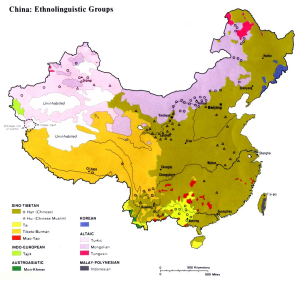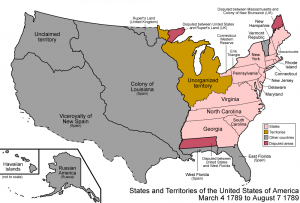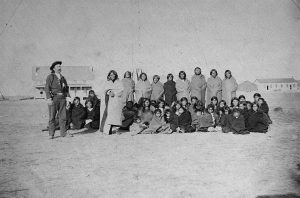
Last week I undertook to unpack the question “What was history’s greatest empire?” In so doing, I discussed numerous possible criteria of greatness while refraining from ever actually answering the question. For those looking for my final answer in this post, I make no guarantees you will be satisfied, but perhaps I can supply a more solid proposal than last time. As I remarked in the conclusion of my last post, all the empires I had discussed therein and, I would hazard, most if not all empires that generally come to mind were ultimately unfinished. This concept of ‘unfinished empire’ was most notably applied to that of Britain by historian John Darwin in his book of the same name, but it can just as easily be seen as a problem inseparable from any empire’s rule. As empires pursue their expansion they become increasingly hierarchical states, with power radiating outwards and downwards from the imperial core and administration to the borders of imperial territory and sovereignty. Conquered peoples are incorporated into this hierarchy on the bottom, with possible mobility within this hierarchy varying greatly from empire to empire. Some have offered the real opportunity to integrate ever higher into the privileged imperial echelons through acculturation and similar modes of worship, as in the case of Rome or the Umayyad/Abbasid Caliphates. Others adhered to strict partition between conqueror and conquered, the uppermost ranks being kept out of reach through ideas mostly boiling down to some form of racism or ethnocentrism, as in the case of the modern European empires. Captured territories soon found their resources, always the fundamental inspiration behind imperialism, extracted back to the core for benefit of the metropole and its original state, leaving its (now-powerless) inhabitants both dependent on the empire for survival and resentful towards their oppressors. Needless to say, this model of state formation and empowerment is inherently unstable and requires an overwhelming superiority of force to make it function for any length of time; any flaw or misstep can prove fatal to part or all of the empire. What, then, might be our conclusion to my question if ever an empire was able to somehow break this mold? What if an empire were able to successfully integrate its conquered territories into the core, forming not a hierarchical empire but a cohesive, functioning state? Is this a ‘finished’ empire at last, and would such a state not at the very least earn careful consideration for the title of ‘greatest’?

Of the handful of high-profile empires I discussed in my previous post, only two have even begun to approach what might be called ‘finished’: Rome and China under the Han Dynasty. You might recognize these as two of the three empires most prominent in my discussion of legacy as a criterion. This is no coincidence; both of their historical shadows have much to do with how close the came to crossing their imperial finishing lines. Within the parameters I’ve laid out above, in fact, Rome crossed it in theory if not in practice. Rome had ceased expanding by the end of the second century AD, and while its subject peoples may not have been exactly happy to live under Roman rule, internal unrest going forward was mostly a result of power struggles between Romans or Romanized elites for control of the empire rather than rebellions or attempts at independence. In AD 212 the emperor Caracalla issued the Constitutio Antoniniana, also called the Edict of Caracalla. In it, the emperor extended Roman citizenship to all free (non-slave) men within the Roman Empire. Reserved almost exclusively for the Italians since 88 BC (and only extended beyond the city of Rome as a result of the ‘Social War’ between Rome and its Italian satellite cities), Roman citizenship conveyed certain legal benefits, protection from some forms of punishment, and the ability to be directly taxed, as well as the right to vote in Roman elections. Though certainly magnanimous on paper, this ‘Caracallan Threshold’ was mostly decorative. One could only exercise the right to vote within the walls of Rome itself, and elections were themselves stripped of all but symbolic importance by this later stage of the empire. Roman society realigned its hierarchy relatively quickly, this time along class lines, reserving the traditional benefits of citizenship for the upper classes and stripping them from the poor. The Edict thus ultimately did little more than widen the tax base (which may have been its purpose all along), yet with it one could reasonably argue that, from 212, Rome was no longer an empire but a state. Its eventual collapse in the west during the fifth century and long decline in the east would come as a result of outside forces exerting irresistible pressure on its decaying institutions, not through internal dissolution. Han China may not have been so official in its integration, but its effects have proven much more permanent. Founded in 202 BC through conquest by Liu Bang, later known as the Emperor Gaozu, after the violent death of the first imperial dynasty of Qin, Han China initially encompassed the area first unified by Qin. Later campaigns would add much of what is today modern China, but the stability and longevity of the Han would impart two fundamental changes to Chinese tradition. It first confirmed the idea of unification as a lasting institution, changing the interpretation of the term zhongguo (loosely, the Chinese term for their own lands) from “Middle Kingdoms” to a singular “Middle Kingdom,” wherein periods of disunity were now considered aberrations and unification the norm. Even more importantly, the inhabitants of the core of this Han zhongguo, approximately the Yellow and Yangtze River valleys, redefined their ethnic identity into one unified community, which has ever since been called Han Chinese. Han dynastic rule over China, however, would end in AD 220 after centuries of deteriorating administration, falling prey to the power struggles that continuously wracked the emperor’s court.
If, despite their legions of successes, these two shining imperial examples failed to finish their formation, what other empire could hope to stand before them? Perhaps, as I mentioned in my introduction, we are not actually looking for an empire at all, but a state? A state which, as it now exists, seems so unified, so indivisible, that its prior existence as an empire is long past or overlooked as such? Could we even begin to consider, perhaps, the United States of America?

For some, the idea of the US as an empire might come as no surprise; to others, it may well be blasphemy. Most, however, do not truly realize the full extent of America’s imperial tradition. From the first settlement of English colonists on the shores of the New World, America has been an empire. In this context, such a statement seems obvious. Until 1776 the English (and, after 1707, British) colonies on North America’s Atlantic seaboard were part of their mother empire. Yet the settlers of these colonies pursued their own thirst for expansion that at times was permitted by the empire and at others was curtailed. Colonization inland during that first century and a half was haphazard as colonists competed with native inhabitants, rival empires, rival colonies, and the policies of Britain herself. After gaining its independence, however, the wave of settlement that had stretched the fledgling United States across the Appalachians would carry it beyond the Mississippi, over the Rockies and up to the waves of the Pacific. American settlers conquered the land as surely as Caesar’s legions conquered Gaul, but instead of swords they blazed their way using plowshares and were aided by pandemic diseases. This unique process of imperialism has become known as ‘settler colonialism,’ and brought with it a package of racism and utter disregard for indigenous peoples that resulted in numerous conflicts that approached, if not outright crossed, the line of genocide. As the British East India Company expanded its holdings in India and France subdued what is now Vietnam, the US Cavalry drove native peoples from their lands and Congress passed the Homestead Act. As European powers negotiated their ‘unequal treaties’ with China, the US government negotiated and then broke treaties with native tribes a staggering number of times. The year 1876 saw US forces defeated by the Lakota, Cheyenne, and Arapaho, only three years before the defeat of British infantry at Isandlwana by the spears of the Zulu. Nor was the United States alone in these endeavors. Canada and Australia, its English-speaking settler cousins, also pursued colonial expansion in what some historians have called the ‘settler revolution’. Australia even went so far as to deny the existence of its aboriginal inhabitants in policy stemming from an initial (and obviously mistaken) survey that had described the continent as uninhabited. Both Canada and Australia remained part of the British Empire and Commonwealth for most of their history, however, and lack the singularity of America for the purposes of this exercise. The American Frontier was officially pronounced closed in 1890, leading historian Frederick Jackson Turner to theorize about its role in American society and the implications of its loss as an outlet for and driver of aggression, ambition, and ingenuity. Only eight years later, the United States would gain its more conventional (and more conventionally lost) island empire through war with Spain. Historians have advanced masculinity, economics, national reconciliation, and myriad other explanations for the war, but equally plausible is a continuity of imperialism, now directed outside the United States after it had consumed the most readily-available target.

The mechanisms of settler colonialism cloak their empire with a different, more subtle façade. Though native peoples were brutally colonized, the acquisition of the land itself was given the appearance of respectability. Rather than hold them in some form of second-class territorial status indefinitely, the United States Constitution outlined provisions for the integration of territories as full-fledged member states based on their population. The settlers who made up those territories’ officially recognized inhabitants were by and large members of the elite imperial racial group, if not the upper classes, and so were afforded every privilege of citizenship in the United States. Nevertheless, the resources of continental American territories were certainly extracted on something approaching an imperial model. Historian James Belich has observed a pattern in the waves of settlement that created the “Anglo-world” during the nineteenth century, beginning with an initial settlement boom based on little more than growth for growth’s sake and sustained in the short term by alluring but unstable cash crops. When this bubble burst for lack of a solid foundation, the financing institutions of the imperial core experienced grave depressions and panics. Busted territories were then ultimately ‘re-colonized,’ aligned back towards the core as they supplied bulk staple goods that provided a low but stable profit margin. This process transformed the American West into fuel for the eastern seaboard’s urbanization, allowing New York to sustain more than a million inhabitants before it should have theoretically been able to, just as Canada and Australia did for London. The integration of states on equal footing and changing patterns of industrialization and urbanization across the US have since obscured this relationship and cast the illusion of a stable nation-state, yet America remains in some aspects an imperial state, especially regarding the continued oppression of colonized peoples within its racial hierarchy. Shuttled to reservations on less and less desirable land, Native Americans possess the highest rates of unemployment and poverty than any other group in the United States, while First Nations peoples in Canada struggle with an epidemic of suicide within their communities. Treated for centuries as an extracted resource, black Americans also suffer from similar systemic repression, not to mention the legal limbo that constrains the peoples of the US’s remaining island possessions. Though some progress has been made towards greater native sovereignty and advocacy, the US continues to ignore and break its treaties with indigenous peoples, as in the recent case of the construction of the Dakota Access Pipeline across the Standing Rock Sioux Reservation. Perhaps the greatest achievement of the American settler empire is not the elimination of unrest but its neutering. The prospect of armed insurrection is unthinkable; discontent is channeled through the political system, and even the infamous race riots of the twentieth century did not result in declarations of autonomous states. The decolonization of America and complete return of native land is now all but inconceivable; the suggestion that America was ever anything but a free and equal democratic state, heresy.
Before I can crown America my (dubious) champion, however, my own previous criteria for greatest empire may well prove my undoing. Currently the finest example of imperial integration we have, the United States does not quite measure up in other terms, though it isn’t necessarily disappointing either. It covers 3.8 million square miles, making it the eleventh largest empire in history, and it has existed as its own state for only 241 years. Considering the establishment of Jamestown in 1607 as origin brings this number to 410 years, only sixteen short of the Han Dynasty. With 169 of those years being under British rule, of course, this becomes a bit of a stretch. Stability and humanity I have discussed at some length above, and profit and legacy are of course impossible to determine as we cannot know what lies ahead. On this shaky ground, I fear America probably cannot quite be considered for grand prize, though it is certainly in the running. Perhaps America shall stand the test of time and history, or perhaps it shall crumble like Britain and Rome before it. My original question remains unanswered, and perhaps that is the most fitting state for it: unfinished, like its subjects littering the graveyard of the past.
Sources and Further Reading
Beard, Mary. SPQR: A History of Ancient Rome. New York: W. W. Norton & Company, 2016.
Belich, James. Replenishing the Earth: The Settler Revolution and the Rise of the Anglo-World, 1783-1939. New York: Oxford University Press, 2009.
Darwin, John. Unfinished Empire: The Global Expansion of Britain. New York: Bloomsbury, 2012.
Keay, John. China: A History. New York: Basic Books, 2009.

One reply on “Grand Prize, or Honorable Mention? The Case of American Settler Empire”
Astute analysis. I’ve always found it highly questionable how “manifest destiny” is still taught in schools with relatively little focus on what that actually meant re: feeling divinely privileged to land that people already lived on.
Another modern example of the US, and in this case other current governments, reneging on Native rights was the passport debacle in 2010. The Native team was denied access to the England-hosted world lacrosse championships because they refused to recognize their Six-Nation passports as valid because they were not viewed as a sovereign nation; something which had not been an issue in the past to other countries. As a result, the Native team was not allowed to compete internationally in a championship for a sport that they invented. This passport is also currently not recognized as valid in Canada either.